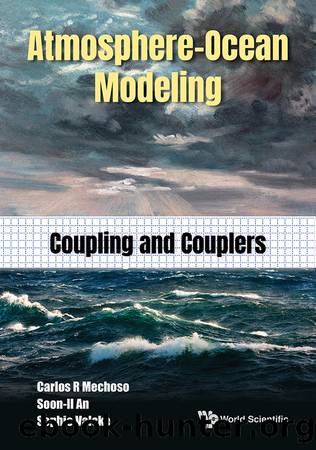Atmosphere-ocean Modeling: Coupling And Couplers by Mechoso Carlos Roberto;An Soon-il;Valcke Sophie;

Author:Mechoso, Carlos Roberto;An, Soon-il;Valcke, Sophie;
Language: eng
Format: epub
Publisher: World Scientific Publishing Company
Published: 2021-10-15T00:00:00+00:00
Figure 7.5. Anomaly correlation skill for OctoberâDecember average SST for ensemble predictions starting on 1 February performed with (a) a fully global CGCM, and (b) the same model except for Atlantic SST restored to observations. The prediction period is 1980â2005. In (b), regions in color and non-stippled indicate where using observed Atlantic SST leads to a significant increase in skill at the 5% level. (Adapted from Figure 1 in Keenlyside et al. [2013].)
7.5 Long-term predictions
CGCMs are indispensable tools for predicting and studying a variety of atmospheric phenomena from day-to-day weather changes to long-term climate variations. If an uncoupled AGCM is to be used for NWP, then surface conditions have to be prescribed from some additional source. An obvious first choice has been to keep the SST and sea-ice state constant during the forecast or taken from an observed climatology. One can ask to what extent in time can interactions with the ocean be neglected. The answer is a resounding ânoâ in reference to timescales beyond the medium range (about 10 days). It has been recognized that the ability to predict climate on seasonal timescales arises from the interaction of the atmosphere with the slower varying components of the climate system [Keenlyside et al., 2021]. The case for seasonal forecasts has been made by the usefulness of seasonal forecasting in the tropics. Predictions of ENSO using both dynamical and statistical models have been examined in Ch. 3. This usefulness has allowed for development of a system for seasonal forecasts using an AGCM with boundary conditions over the tropical oceans provided by other predictions systems. Such a methodology is referred to as a âtwo-tier forecast systemâ. The reader is referred to Misra et al. [2013] and Li and Misra [2013] for examples of this methodology and its performance.
Download
This site does not store any files on its server. We only index and link to content provided by other sites. Please contact the content providers to delete copyright contents if any and email us, we'll remove relevant links or contents immediately.
Man-made Catastrophes and Risk Information Concealment by Dmitry Chernov & Didier Sornette(4728)
The Revenge of Geography: What the Map Tells Us About Coming Conflicts and the Battle Against Fate by Kaplan Robert D(3596)
Zero Waste Home by Bea Johnson(3285)
COSMOS by Carl Sagan(2944)
In a Sunburned Country by Bill Bryson(2941)
Good by S. Walden(2909)
The Fate of Rome: Climate, Disease, and the End of an Empire (The Princeton History of the Ancient World) by Kyle Harper(2429)
Camino Island by John Grisham(2379)
A Wilder Time by William E. Glassley(2358)
Organic Mushroom Farming and Mycoremediation by Tradd Cotter(2304)
Human Dynamics Research in Smart and Connected Communities by Shih-Lung Shaw & Daniel Sui(2174)
The Ogre by Doug Scott(2105)
Energy Myths and Realities by Vaclav Smil(2054)
The Traveler's Gift by Andy Andrews(2007)
Inside the Middle East by Avi Melamed(1937)
Birds of New Guinea by Pratt Thane K.; Beehler Bruce M.; Anderton John C(1905)
Ultimate Navigation Manual by Lyle Brotherton(1764)
A History of Warfare by John Keegan(1712)
And the Band Played On by Randy Shilts(1612)
